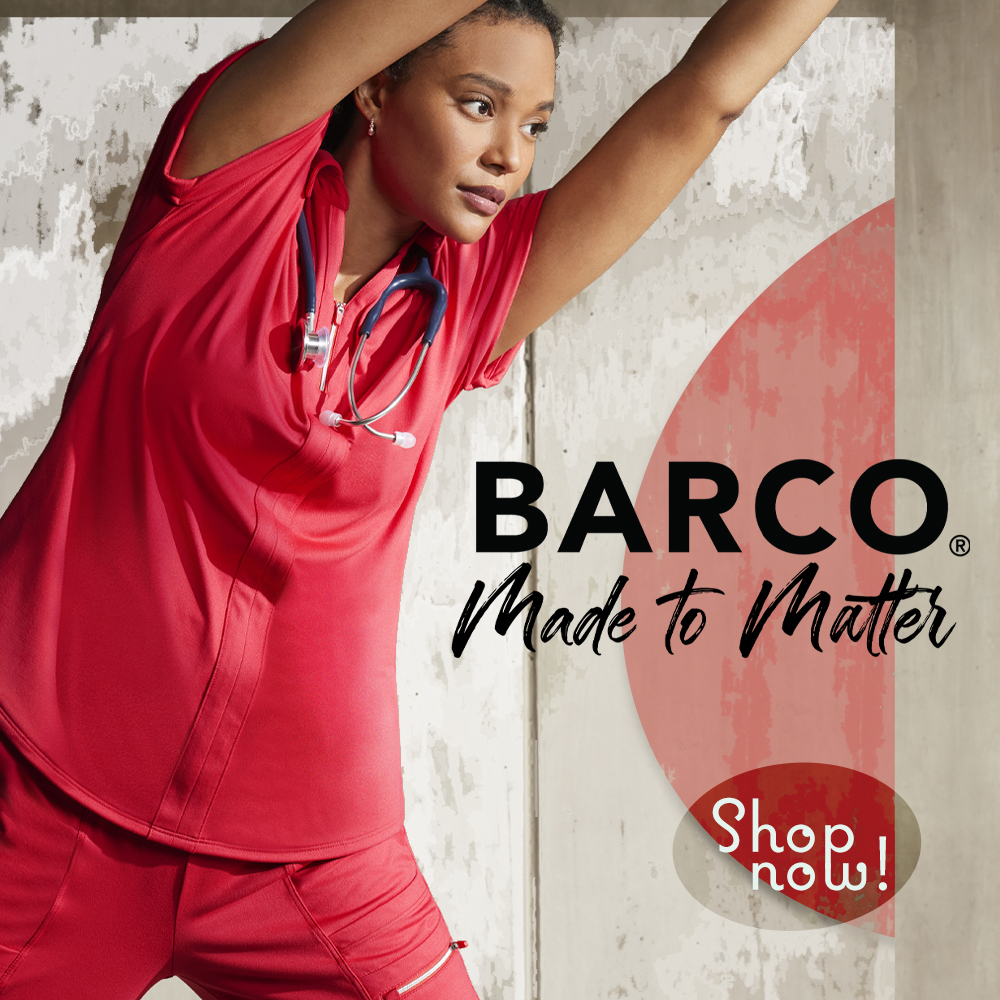A1 SCRUBS FAQ'S ON MEDICAL SCRUBS AND UNIFORMS
Welcome to our comprehensive FAQ page dedicated to medical scrubs. Whether you're a healthcare professional, a medical student, or a uniform supplier, this resource is designed to answer your most pressing questions about medical scrubs, covering everything from fabric choice to sizing, care, and even the latest trends. Find out what people ask about the latest in medical scrubs fashion, safety and significance in the healthcare industry.
SHOP OUR MOST POPULAR MEDICAL SCRUBS BRANDS: CHEROKEE | DICKIES | GREY'S ANATOMY | HEALING HANDS | JOCKEY | LANDAU | MED COUTURE
Best Material for Medical Scrubs
Q: What types of fabric are most suitable for medical scrubs?
A: The best materials for medical scrubs are those that offer durability, comfort, and suitability for healthcare settings. Common choices include cotton-polyester blends for their breathability and ease of care, and rayon blends for their softness. Some scrubs also feature spandex for added flexibility.
Care and Maintenance of Medical Scrubs
Q: What are the best practices for washing and maintaining medical scrubs?
A: To extend the life and appearance of medical scrubs, wash them in cold water with similar colors and tumble dry on low. Avoid using bleach to preserve fabric integrity. Iron on low heat if necessary. Promptly removing scrubs from the dryer can reduce wrinkles.
Antimicrobial Medical Scrubs
Q: What are antimicrobial medical scrubs and their benefits?
A: Antimicrobial medical scrubs are treated with antimicrobial agents to inhibit the growth of bacteria and other microbes. This feature enhances safety and hygiene, making them ideal for healthcare settings. These scrubs can help reduce cross-contamination and provide an additional layer of protection.
Cost of Medical Scrubs
Q: What is the typical price range for medical scrubs?
A: The cost of medical scrubs varies depending on quality, brand, and features. Basic scrubs can start from as low as $12 per piece, while high-end, feature-rich scrubs can go up to $50 or more. Bulk purchases for institutions may qualify for discounts.
Custom Medical Scrubs
Q: Can medical scrubs be customized, and what are the options?
A: Yes, medical scrubs can be customized. Options include embroidery of names or logos, varied color choices, and specific design features like pockets or trim. Customization is often used for branding purposes or personal preference.
Medical Scrubs for Different Specialties
Q: Are there specific types of scrubs recommended for various medical specialties?
A: Certain medical specialties may have specific requirements for scrubs. For instance, surgical scrubs are often designed to be sterile and might have extra pockets. Pediatrics might favor scrubs with child-friendly patterns. However, most standard scrubs are suitable for various medical fields.
Eco-Friendly Medical Scrubs
Q: What are eco-friendly medical scrubs, and where can they be found?
A: Eco-friendly medical scrubs are made from sustainable materials like organic cotton or recycled polyester. They are designed to minimize environmental impact. These can be found at specialty retailers or online stores focusing on sustainable medical wear.
Fashionable Medical Scrubs
Q: What are the latest trends in medical scrub designs?
A: The latest trends in medical scrubs include modern, form-fitting designs, a wide range of colors and patterns, and features like jogger-style pants. Fashionable scrubs aim to combine professional standards with contemporary style.
Medical Scrubs vs. Hospital Uniforms
Q: What is the difference between medical scrubs and other hospital uniforms?
A: Medical scrubs are specifically designed for healthcare providers, offering functionality and ease of movement. Hospital uniforms might include lab coats, gowns, or administrative attire, each serving different roles and offering varying levels of protection and professionalism.
Scrubs for Different Body Types
Q: How to find medical scrubs that fit well for various body types?
A: To find scrubs that fit well, look for brands that offer a wide range of sizes, including petite, tall, plus sizes, and those with adjustable features. Comfort should be the priority, ensuring the scrubs are neither too tight nor too loose.
History of Medical Scrubs
Q: What is the historical development of medical scrubs?
A: Medical scrubs evolved from the white surgical gowns used in the early 20th century. The shift to green or blue scrubs occurred to reduce eye strain from white glare and to make blood and other stains less conspicuous. Over time, scrubs have become standardized in healthcare.
Medical Scrubs Color Significance
Q: What do different colors of medical scrubs signify?
A: Different colors of medical scrubs can signify different roles or departments within a healthcare facility. For example, blue might be worn by nurses, green by surgeons, and so on. However, this varies by institution, and some allow personal choice in scrub color.
Scrubs for Sensitive Skin
Q: Are there specific types of scrubs recommended for sensitive skin?
A: For sensitive skin, look for scrubs made from hypoallergenic materials like 100% cotton or bamboo fabric, which are softer and less likely to cause irritation. Avoid scrubs with harsh dyes or chemical treatments.
Gender-Specific vs. Unisex Scrubs
Q: What is the difference between gender-specific and unisex medical scrubs?
A: Gender-specific scrubs are tailored to fit the different body shapes of men and women, offering a more personalized fit. Unisex scrubs are designed to fit a wide range of body types and are often more generic in fit.
Scrubs and Professional Image
Q: How do medical scrubs impact the professional image of healthcare workers?
A: Medical scrubs play a crucial role in the professional image of healthcare workers. They signify cleanliness, professionalism, and readiness for duty. The style, fit, and cleanliness of scrubs can significantly affect how patients and colleagues perceive healthcare professionals.
Innovations in Medical Scrubs
Q: What are the latest innovations in medical scrubs?
A: Recent innovations in medical scrubs include antimicrobial fabrics, moisture-wicking technology, and stretchable materials for enhanced comfort. There are also advances in sustainable fabrics and designs that incorporate more pockets and ergonomic features.
Medical Scrubs for All Seasons
Q: Are there specific scrubs suitable for different weather conditions?
A: Yes, there are scrubs designed for different weather conditions. For warmer climates, look for scrubs made from lightweight, breathable fabrics. For colder settings, scrubs with thicker material or the ability to layer undergarments are advisable.
Scrubs Storage and Organization
Q: What are effective ways to store and organize medical scrubs?
A: Effective ways to store and organize medical scrubs include using separate compartments or hangers to keep clean and used scrubs separate. Labeling drawers or shelves based on scrub size, color, or department can also aid in organization.
Medical Scrubs and Hygiene
Q: How do medical scrubs contribute to hygiene in healthcare settings?
A: Medical scrubs contribute to hygiene by being easily washable at high temperatures, reducing the risk of contamination. Their design limits pockets and crevices where pathogens can accumulate, and antimicrobial fabrics add an extra layer of protection. However, new fabrics offer the same protection while laundering at lower temperatures. See label care instructions for best results.
Medical Scrubs and Workplace Compliance
Q: Are there specific regulations or guidelines for medical scrubs in healthcare settings?
A: Yes, healthcare facilities often have specific regulations and guidelines regarding medical scrubs to ensure safety, hygiene, and professional appearance. These guidelines can include requirements for color-coding by department, specific fabric choices to meet hygiene standards, and rules about personalization or additional features like pockets. Always check with your facility's dress code policy to ensure compliance.
Impact of Medical Scrub on Patient Perception
Q: How do medical scrubs influence patient perception and comfort?
A: Medical scrubs can significantly impact patient perception and comfort. Clean, well-fitting scrubs in calming colors can help patients feel more at ease and convey a sense of professionalism and competence. Scrubs with friendly patterns or bright colors can be particularly comforting in pediatric or family healthcare settings. The appearance and condition of a healthcare provider's scrubs can enhance trust and confidence in the care being provided.







